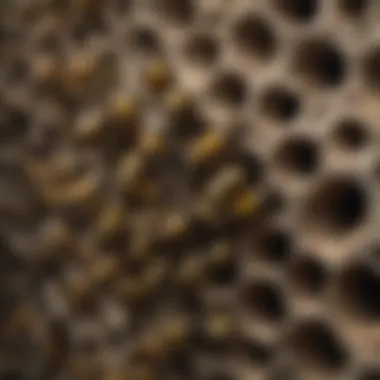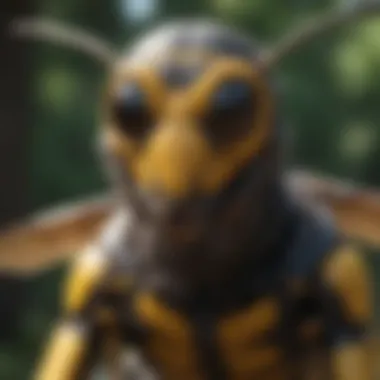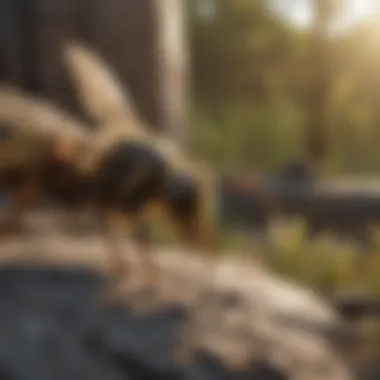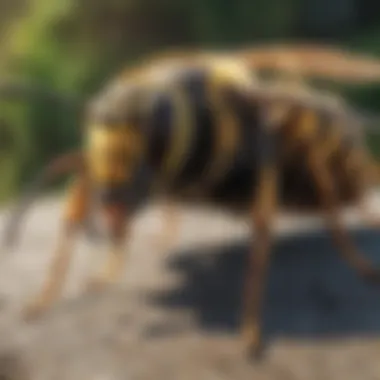Expert Strategies for Effective Outdoor Wasp Control Solutions


Preventive Pest Control Strategies
Preventive pest control strategies are crucial in maintaining a pest-free outdoor environment. Begin by focusing on protecting your house exterior. Sealing cracks and gaps in your home’s exterior is essential to prevent pests, including wasps, from making their way inside. Clearing debris such as fallen leaves and branches can eliminate potential nesting spots for wasps. Additionally, implementing measures to stop pests from entering your living spaces, such as using weather-stripping and sealing entry points, is effective in minimizing infestations.
When it comes to yard maintenance, adopt essential routines like regular mowing, trimming vegetation, and removing standing water to keep your yard pest-free. Practicing good indoor cleanliness habits, such as proper waste disposal, vacuuming, and de-cluttering, can significantly reduce pest populations indoors. Furthermore, ensuring garbage is disposed of efficiently and correctly plays a vital role in deterring pests from your property. Explore innovative strategies beyond traditional methods to safeguard your home against potential pest invasions.
Identifying Pest Risk Areas
Conducting thorough inspections of moisture-prone areas is imperative to identify potential pest breeding grounds. By recognizing and addressing damp conditions promptly, you can hinder pest infestations from taking root. Inspecting cracks and crevices around your property is equally essential, as these openings serve as entry points for pests. Seal off these access points efficiently to prevent pests from infiltrating your living spaces. Evaluate the impact of greenery on pest presence and implement guidelines to maintain a yard environment that is unattractive to pests. Finally, consider other lesser-known areas that may pose risks for pest infestations and take preventive measures accordingly.
Effective Pest Control Methods
Utilize natural repellents derived from essential oils, herbs, and plants to deter pests like wasps in an environmentally friendly manner. Chemical sprays, when used safely and as directed, can effectively eradicate existing pest populations. Employ pest traps strategically to capture and remove pests without harming them. Explore biological control methods that leverage natural predators to manage pest populations sustainably. Embrace innovative pest control solutions beyond conventional approaches to address diverse pest challenges effectively.
Pest Species Identification
Familiarize yourself with common home-invading insects such as ants, cockroaches, and spiders to implement targeted pest management strategies. Learn to identify rodents like mice and rats and take proactive steps to prevent infestations. Address issues related to disruptive bird species around your property to mitigate conflicts. Develop effective measures to handle encounters with wildlife and prevent potential threats they may pose. Additionally, equip yourself with the knowledge to manage and control lesser-known pest species effectively.
DIY Pest Control Techniques
Explore eco-friendly homemade pest control remedies using readily available ingredients to protect your home from pests. Harness the repellent properties of essential oils to create a bug-free environment indoors. Set up pest traps and barriers strategically to control and prevent infestations effectively. Discover reputable pest control brands and their products that offer reliable solutions for home pest management. Delve into unique do-it-yourself pest control techniques to address various pest issues creatively.
Understanding Wasps
Understanding wasps is a crucial component in effectively managing outdoor spaces as it provides valuable insights into the behavior and characteristics of these stinging insects. By delving into the world of wasps, individuals can better comprehend how these creatures operate, thus enabling them to take appropriate actions to control and prevent infestations. The significance of understanding wasps lies in the fact that it forms the foundation for implementing strategic measures to safeguard outdoor areas from potential risks and disturbances.
Characteristics of Wasps
Physical Attributes
When exploring the physical attributes of wasps, it's important to consider their distinct features such as slender bodies, elongated wings, and vibrant colors. These characteristics play a vital role in helping wasps adapt to various environments and fulfill their roles within the colony. The sleek form of their bodies allows for quick and agile movements, facilitating efficient hunting and communication among nest members. The ability of wasps to display warning colors serves as a natural defense mechanism, deterring potential threats and helping other creatures identify them as hazardous. Understanding the physical attributes of wasps is crucial for identifying different species and determining the best course of action for controlling infestations.


Behavioral Patterns
The behavioral patterns of wasps offer valuable insights into how they interact with their surroundings and each other. From foraging for food to defending their nests, these social insects exhibit complex behaviors that contribute to the overall functioning of the colony. One key characteristic of wasp behavior is their hierarchical structure, with distinct roles assigned to queen, workers, and drones. This division of labor ensures the smooth operation of the nest and the survival of the population. Additionally, wasps demonstrate territorial behavior, vigorously protecting their nest from threats. By understanding the behavioral patterns of wasps, individuals can predict their actions, effectively manage infestations, and reduce the likelihood of encounters that may result in stings.
Types of Wasps
Common Species
Exploring common species of wasps reveals a diverse range of insects with unique characteristics and nesting habits. Species such as yellow jackets and paper wasps are frequently encountered in outdoor spaces due to their adaptable nature and ability to thrive in various environments. Yellow jackets, known for their aggressive behavior, are attracted to sugary substances, making them common pests at outdoor events. Paper wasps, on the other hand, construct umbrella-shaped nests under eaves and ledges, displaying intricate nest-building capabilities. Understanding the common species of wasps enables individuals to differentiate between them, identify potential infestations, and implement targeted control strategies.
Nesting Habits
The nesting habits of wasps vary depending on the species and environmental factors influencing their choice of nesting sites. Some wasps build paper nests suspended from tree branches or structures, while others excavate underground tunnels for their colonies. Understanding the nesting habits of wasps is essential for pinpointing nest locations, assessing the level of threat posed, and determining the most effective control methods. By recognizing the unique features of nest structures and placement preferences, individuals can take proactive measures to prevent infestations and safeguard outdoor areas from potential risks.
Identifying Wasp Infestations
Identifying wasp infestations is a crucial aspect of outdoor wasp control that forms the foundation of effective pest management strategies. By focusing on specific elements such as recognizing signs of wasp activity, homeowners can take proactive steps to safeguard their property and the well-being of their household. Understanding the behavior and habits of wasps is essential in identifying potential infestations early on, preventing escalated issues down the line.
Signs of Wasp Activity
Visible Nests
Visible nests serve as tangible evidence of a wasp colony's presence, making them a key indicator of potential infestations. These physical structures, often built in secluded outdoor areas, play a vital role in the nesting habits and social structure of wasps. Recognizing visible nests enables homeowners to locate and address infestations promptly, minimizing the risk of stings and property damage. However, approaching nests can be dangerous, requiring caution and potentially necessitating professional intervention for safe removal.
Increased Wasp Presence
An uptick in wasp sightings or activity signals an increased wasp presence, indicating a thriving colony nearby. Monitoring the frequency of wasp encounters is essential for assessing the extent of an infestation and devising appropriate control measures. Understanding patterns of increased wasp presence, such as during certain times of the day or in specific locations, can help homeowners uncover nest locations and implement targeted interventions. While heightened wasp activity can be unsettling, swift action guided by thorough identification is key to managing infestations effectively.
Risk Factors
Allergic Reactions
Allergic reactions to wasp stings pose a significant risk to individuals, especially those with known sensitivities to insect venom. Recognizing the symptoms of an allergic reaction, such as swelling, hives, or difficulty breathing, is crucial for prompt medical attention. Understanding the potential severity of allergic responses underscores the importance of preventive measures and swift intervention in managing wasp infestations. Minimizing exposure to wasps and administering necessary medical treatment in case of stings can prevent serious health complications.


Property Damage
Wasp infestations can lead to property damage, particularly in areas where nests are built in close proximity to human habitation. Wasp colonies may cause structural harm by burrowing into wood or creating nests in eaves and attics, posing risks to building integrity. Identifying signs of property damage, such as chewed wood or warped structures, is essential for early intervention and preventing extensive repairs. Addressing property damage caused by wasp infestations requires a combination of nest removal, structural repairs, and long-term prevention strategies to mitigate financial and structural risks.
Preventive Measures
Preventive measures play a crucial role in the comprehensive outdoor wasp control guide. By proactively addressing potential issues, individuals can significantly reduce the risk of wasp infestations in their outdoor spaces. These measures not only help in preventing the presence of wasps but also contribute to creating a safer environment for oneself and family members. Understanding and implementing preventive measures is key to maintaining a pest-free outdoor area.
Environmental Modifications
Removing Food Sources
Removing food sources is a fundamental aspect of preventive measures in the battle against wasp infestations. By eliminating access to food, particularly sweet substances that attract wasps, individuals can disrupt the reproductive cycle of these insects. This strategy is effective in reducing the overall attractiveness of the area to wasps and discouraging them from building nests nearby. The absence of food sources serves as a natural deterrent, leading to a decreased presence of wasps, thus enhancing outdoor enjoyment. While removing food sources requires consistency and diligence, the long-term benefits of a wasp-free environment make it a popular and worthwhile choice for those aiming to protect their outdoor spaces.
Sealing Entry Points
Sealing entry points is another essential component of preventive measures in outdoor wasp control. By identifying and sealing off potential entryways into buildings or outdoor structures, individuals can prevent wasps from establishing nests in close proximity. This action not only limits the opportunity for wasps to infiltrate living spaces but also reduces the risk of unwelcome encounters. The key characteristic of sealing entry points lies in its proactive nature, as it tackles the root cause of infestations by blocking off avenues for wasps to enter. While it requires careful inspection and meticulous sealing, the advantages of this practice are undeniable in safeguarding against wasp intrusions and maintaining a secure outdoor environment.
Natural Deterrents
Essential Oils
Essential oils serve as a valuable natural deterrent in the realm of outdoor wasp control. Certain essential oils, such as peppermint or lemongrass, possess properties that repel wasps due to their strong scents. By strategically placing these oils around outdoor areas or incorporating them into DIY sprays, individuals can create an inhospitable environment for wasps, encouraging them to seek alternate locations for nesting. The unique feature of essential oils lies in their dual functionality of serving as both repellents and natural air fresheners, making them a versatile and eco-friendly choice for wasp control. While essential oils may require periodic reapplication and experimentation to find the most effective scent, their potential in deterring wasps without harmful chemicals makes them a favored option among environmentally conscious individuals.
Plants
Plants play a significant role in natural wasp deterrents, offering both aesthetic appeal and functional benefits in outdoor spaces. Certain plants, such as spearmint or citronella, emit odors that repel wasps naturally. By strategically planting these species around the perimeter of a yard or near gathering areas, individuals can create a protective barrier that deters wasps from frequenting the vicinity. The key characteristic of plants as deterrents lies in their ability to blend seamlessly into outdoor landscapes while serving a practical purpose in warding off unwanted pests. The unique feature of using plants for wasp control is their low maintenance requirements and sustainable nature, providing a long-term solution for those seeking a harmonious balance between aesthetics and insect deterrence. While plants may vary in effectiveness depending on species and growing conditions, their overall advantages in promoting a wasp-free outdoor environment make them a favorable choice for eco-conscious homeowners.
Safe Wasp Control Methods
Non-Toxic Approaches
Soap and Water Solution


The use of a soap and water solution is a fundamental non-toxic approach that serves as an effective tool in combating wasp infestations. This mixture disrupts the protective layer of wasps and ultimately suffocates them. Its simple composition and ease of application make it a popular choice for those seeking a safe yet efficient solution. The key characteristic of this method lies in its non-harmful nature towards the environment and individuals, making it a desirable option for managing wasp issues. Additionally, the soap and water solution is readily available and cost-effective, providing a practical and accessible means of wasp control. While this approach is eco-friendly and humane, it may require repeated application to ensure long-term effectiveness.
Vacuuming
Vacuuming is another non-toxic method that can aid in the removal of wasps and their nests without the use of harmful chemicals. This technique involves carefully vacuuming up wasps, larvae, and nests, thereby reducing the population and eliminating potential breeding grounds. The key characteristic of vacuuming lies in its non-invasive nature and ability to target specific areas of infestation. By directly capturing and removing wasps, vacuuming proves to be a precise and immediate solution to wasp problems. One unique feature of vacuuming is its versatility in reaching confined or hard-to-access areas where wasps may construct their nests. However, it is essential to handle captured wasps with care to prevent any accidental stings during the disposal process. While vacuuming offers a safe and efficient means of controlling wasps, regular monitoring and maintenance are necessary to prevent re-infestation.
Chemical Treatments
Commercial Sprays
The utilization of commercial sprays is a chemical treatment method commonly employed to eradicate wasp populations quickly and effectively. These sprays contain potent ingredients that target and eliminate wasps upon contact, providing immediate results. The key characteristic of commercial sprays is their rapid action and ability to reach distant or elevated nests with ease. Due to their widespread availability and proven potency, commercial sprays are a popular choice for individuals seeking a swift resolution to wasp infestations. While effective, it is crucial to follow safety precautions and usage instructions provided by manufacturers to minimize environmental impact and ensure personal safety.
Dust Insecticides
Dust insecticides are another chemical treatment option that targets wasps through residual action. These powdery substances are applied in and around nesting areas, creating a barrier that exterminates wasps upon contact or ingestion. The key characteristic of dust insecticides is their long-lasting effects, persisting on treated surfaces to prevent re-infestation. Their ability to penetrate crevices and inaccessible areas makes them a valuable asset in combating hidden nests and hard-to-reach locations. One unique feature of dust insecticides is their versatility in application, allowing for precise targeting of specific zones of wasp activity. While effective in controlling wasps, dust insecticides should be handled with caution to prevent unintended exposure to humans or pets. Regular monitoring and reapplication may be necessary to maintain the desired level of control and protection against wasp infestations.
Professional Intervention
In the realm of outdoor wasp control, Professional Intervention emerges as a crucial component, elevating the efficacy and precision of handling wasp infestations. Engaging professional pest control services amplifies the assurance of a systematic and targeted approach towards eradicating wasp colonies successfully. These experts bring a wealth of experience and knowledge, honed through dealing with a myriad of pest scenarios, ensuring a thorough understanding of wasps' behavior and nesting patterns. Their specialized interventions are designed to not only address existing infestations but also to prevent future recurrences, safeguarding outdoor spaces from potential harm.
Hiring Pest Control Services
Inspection
The Inspection phase constitutes a pivotal aspect of the professional intervention process. Pest control experts conduct meticulous examinations of the infested area, identifying key hotspots of wasp activity and locating nests with precision. This comprehensive assessment allows professionals to formulate tailored treatment strategies, enhancing the overall effectiveness of the control measures. The strategic advantage of inspections lies in their ability to offer a targeted and strategic approach, addressing the root causes of infestation and ensuring a long-term solution.
Treatment Plans
Treatment Plans represent the strategic roadmap crafted by pest control services to combat and mitigate wasp infestations effectively. These plans are customized based on the severity of the infestation, the type of wasps present, and the intricacies of the outdoor environment. By outlining systematic steps and utilizing specialized techniques, treatment plans aim to eliminate wasp colonies efficiently while minimizing environmental impact. The distinct feature of treatment plans lies in their tailored nature, ensuring a personalized and effective approach to each unique infestation scenario.
Considerations
Cost
When considering professional intervention for outdoor wasp control, Cost stands as a practical yet significant consideration. While the expertise and precision offered by pest control services are invaluable, it is essential to weigh the associated costs. The cost factor encompasses various aspects, including the scale of infestation, the complexity of treatment required, and the reputation of the service provider. Balancing the cost implications with the assured quality of service is essential in making an informed decision regarding professional intervention.
Effectiveness
The Effectiveness of professional intervention in outdoor wasp control underscores its importance in achieving successful outcomes. Professional pest control services boast a track record of delivering results, with their strategic treatment plans and specialized tools maximizing effectiveness. By leveraging their expertise and resources, professionals can ensure thorough eradication of wasp colonies, thereby mitigating risks of re-infestation. The unparalleled effectiveness of professional interventions serves as a key pillar in safeguarding outdoor spaces from the threats posed by persistent wasp infestations.



